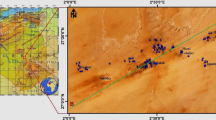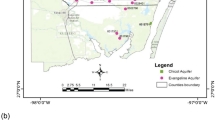Abstract
This work gives us an overview of the groundwater quality and problems pertaining to the occurrence of arsenic (As) and other chemical contaminants in the groundwater of Begusarai district of Bihar, India. The total As concentration in the analyzed water samples varies between 21.5–94.3 μg/L. Through the saturation index using PhreeqC, it was found that most of the samples are saturated for mineral goethite, calcite and dolomite. It was observed that mobilization of arsenic from the alluvial aquifers is mainly affected through the means of reductive dissolution of the iron oxyhydroxides within the sediments. Reductive dissolution of iron oxyhydroxide present as coatings on and around clay layer seems to be the main process responsible for the release of As into groundwater. Close to the Gangetic flood plain most of the tube wells (shallow aquifers) are affected. Groundwater is characterized by slightly alkaline pH with a moderate to strong reducing nature. The water type mainly falls in two categories i.e. Ca–HCO3 and Ca–Cl (with contribution of 75 and 25% of total water type, respectively). Enrichment of \(\mathrm{NO}_{3}^{-}\) at few locations is an indicator of agriculture practice well supported by effluent leaching.
Similar content being viewed by others
References
Ahmed KM, Bhattacharya P, Hasan MA, Akhter SH, Alam MA, Bhuyian H, Imam MB, Khan AA, Sracek O (2004) Arsenic enrichment in groundwater of the alluvial aquifers in the Bangladesh: an overview. Appl Geochem 19:181–200
American Public Health Association (APHA) (1995) Standard methods for the examination of water and wastewater, 19th edn. American Public Health Association, Washington DC, p 1467
Anderson MP (1979) Using models to simulate the movement of contaminants through groundwater flow systems. CRC Crit Rev Environ Control 8:97–156
Avtar R, Kumar P, Singh CK, Mukherjee S (2011) A comparative study on hydrogeochemistry of Ken and Betwa Rivers of Bundelkhand using statistical approach. Water Qual Exposure Health 2:169–197
Bhattacharya P, Chatterjee D, Jacks G (1997) Occurrence of arsenic contamination of groundwater in alluvial aquifers from Delta Plain, Eastern India: option for safe Drinking Water Supply. Int J Water Resour Dev 13:79–92
Bhattacharya P, Hasan MA, Sracek O, Smith E, Ahmed KM, von Brömssen M, Huq SMI, Naidu R (2009) Groundwater chemistry and arsenic mobilization in the Holocene flood plains in south-central Bangladesh. Environ Geochem Health 31:23–44
Chakraborti D, Mukherjee SC, Pati S, Sengupta MK, Rahman MM, Chowdhury UK, Lodh D, Chanda CR, Chakraborti AK, Basu GK (2003) Arsenic groundwater contamination in middle Ganga plain, Bihar, India: a future Danger? Environ Health Perspect 111:1194–1201
Dhar RK, Zheng Y, Stute M, van Geen A, Cheng Z, Shanewaz M, Shamsudduha M, Hoque MA, Rahman MW, Ahmed KM (2008) Temporal variability of groundwater chemistry in shallow and deep aquifers of Araihazar, Bangladesh. J Contam Hydrol 99:97–111
Fisher RS, Mulican WF III (1997) Hydrochemical evolution of sodium-sulfate and sodium-chloride groundwater beneath the Northern Chihuahuan desert, Trans-Pecos, Texas, USA. Hydrogeol J 10(4):455–474
Gebel T (2000) Confounding variables in the environmental toxicology of Arsenic. Toxicology 144:155–162
Hasan MA, Ahmed KM, Sracek O, Bhattacharya P, von Brömssen M, Broms S, Fogelström J, Mazumder ML, Jacks G (2007) Arsenic in shallow groundwater of Bangladesh: investigations from three different physiographic settings. Hydrogeol J 15:1507–1522
Hounslow A (1995) Water Quality Data, p 397
Islam FS, Gault AG, Boothman C, Polya DA, Charnock JM, Chatterjee D, Lloyd JR (2004) Role of metal-reducing bacteria in arsenic release from Bengal delta sediments. Nature 430:68–71
Kim K (2003) Long-term disturbance of groundwater chemistry following well installation. Groundwater 41:780–789
Kumar P, Kumar M, Ramanathan AL, Tsujimura M (2010) Tracing the factors responsible for arsenic enrichment in groundwater of the middle Gangetic Plain, India: a source identification perspective. Environ Geochem Health 32:129–146
Lovley DR, Chapelle FH (1995) Deep subsurface microbial processes. Rev Geophys 33:365–381
McArthur JM, Ravenscroft P, Safiullah S, Thirlwall MF (2001) Arsenic in groundwater: testing pollution mechanisms for sedimentary aquifers in Bangladesh. Water Resour Res 37(1):109–117
Mukherjee A, von Brömssen M, Scanlon BR, Bhattacharya P, Fryar AE, Hasan MA, Ahmed KM, Chatterjee D, Jacks G, Sracek O (2008) Hydrogeochemical comparison and effects of overlapping redox zones on groundwater arsenic near the Western (Bhagirathi sub-basin, India) and Eastern Margins (Meghna sub-basin, Bangladesh) of the Bengal Basin. J Contam Hydrol 99(1–4):31–48
National Academy Press (2001) Arsenic in drinking water: 2001 update. Sub-committee to update the 1999 Arsenic in Drinking Water Report, Goyer, R (Chair). National Academy Press, Washington, DC
Nickson RT, McArthur JM, Burgess WG, Ahmed KM, Ravenscroft P, Rahman M (1998) Arsenic poisoning of Bangladesh groundwater. Nature 395:338
Parkhurst DL, Appelo CAJ (1999) User’s guide to PHREEQC: a computer program for speciation, reaction-path, 1-D transport and inverse geochemical calculations. US geological survey water-resources investigations report, 99–4259
Singh IB (2004) Late Quaternary history of the Ganga Plain. J Geol Soc India 64:431–454
Smith AH, Lingas EO, Rahman M (2000) Contamination of drinking water by arsenic in Bangladesh: a public health emergency. Bull World Health Organ 83:177–186
Sracek O, Bhattacharya P, Jacks G, Gustafsson JP, von Brömssen M (2004) Behavior of arsenic and geochemical modeling of arsenic enrichment in aqueous environments. Appl Geochem 19(2):169–180
Srivastava AK, Govil PC, Tripathi RM, Shukla RS, Srivastava RS, Vaish DP, Nickson RT (2008) Initial data on arsenic in groundwater and development of a state action plan, Uttar Pradesh, India. In: Bhattacharya P, Ramanathan AL, Mukherjee AB, Bundschuh J, Chandrasekharam D, Keshari AK (eds) Groundwater for sustainable development: problems, perspectives and challenges. Taylor and Francis/A.A. Balkema, London/Rotterdam, pp 271–281
Subramanian V, Saxena K (1983) Hydrogeochemistry of groundwater in the Delhi region of India, relation of water quality and quantity. In: Proceedings of the Hamberg symposium IAHS, vol 146, pp 307–316
Tirumalesh K, Shivanna K, Sriraman AK, Tyagi AK (2010) Assessment of quality and geochemical processes occurring in groundwaters near central air conditioning plant site in Trombay, Maharashtra, India. Environ Monit Assess 163:171–184
WHO (1993) Guidelines for drinking water quality: recommendation edn. World Health Organization, Geneva, vols 1–2
Wadia DN (1981) Geology of India. Tata McGraw-Hill, New Delhi, 508 pp
Zheng Y, Stute M, van Geen A, Gavrieli I, Dhar R, Simpson HJ, Ahmed KM (2004) Redox control of arsenic mobilization in Bangladesh groundwater. Appl Geochem 19(2):201–214
Author information
Authors and Affiliations
Corresponding author
Rights and permissions
About this article
Cite this article
Agrawal, D., Kumar, P., Avtar, R. et al. Multivariate Statistical Approach to Deduce Hydrogeochemical Processes in the Groundwater Environment of Begusarai District, Bihar. Water Qual Expo Health 3, 119–126 (2011). https://doi.org/10.1007/s12403-011-0049-4
Received:
Revised:
Accepted:
Published:
Issue Date:
DOI: https://doi.org/10.1007/s12403-011-0049-4




